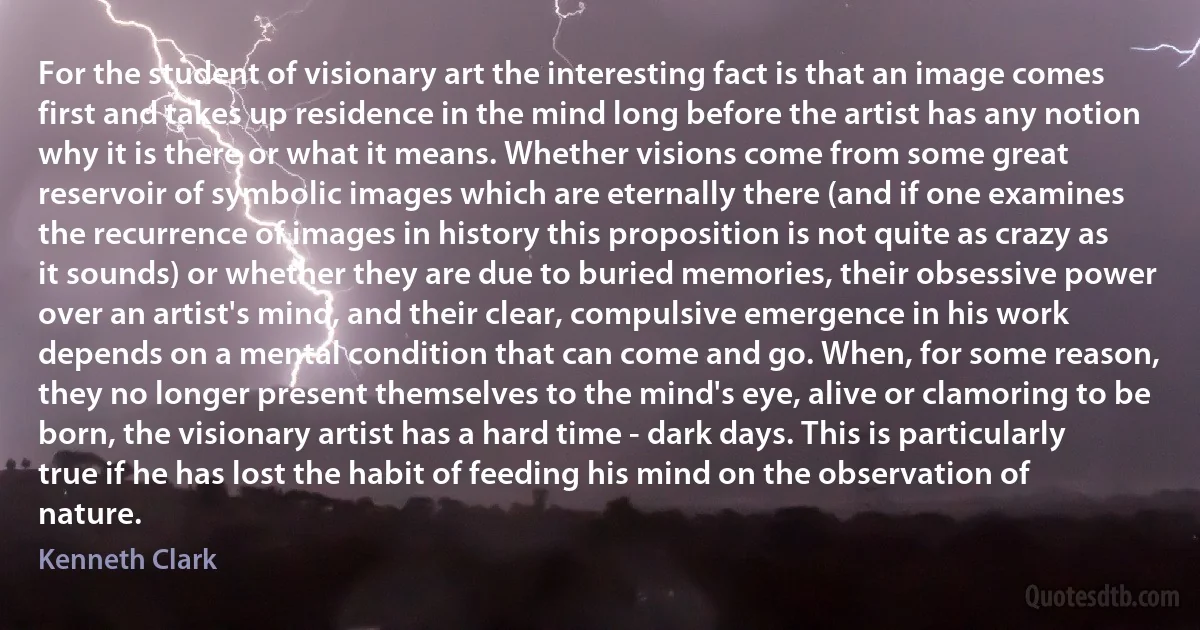
For the student of visionary art the interesting fact is that an image comes first and takes up residence in the mind long before the artist has any notion why it is there or what it means. Whether visions come from some great reservoir of symbolic images which are eternally there (and if one examines the recurrence of images in history this proposition is not quite as crazy as it sounds) or whether they are due to buried memories, their obsessive power over an artist's mind, and their clear, compulsive emergence in his work depends on a mental condition that can come and go. When, for some reason, they no longer present themselves to the mind's eye, alive or clamoring to be born, the visionary artist has a hard time - dark days. This is particularly true if he has lost the habit of feeding his mind on the observation of nature.
Kenneth ClarkRelated topics
art born bury clamoring clear comes compulsive condition crazy dark due emergence eye great habit hard history longer lost mind nature power present quite reason recurrence reservoir residence time visionary work means days obsessiveRelated quotes
The tradition in Hinduism is that it is not open to any Hindu, whatever be the name and mental image of the Supreme Being he uses for his devotional exercises, to deny the existence of God that others worship. He can raise the name of his choice to that of the highest, but he can not deny the divinity or the truth of the God of other denominations. The fervor of his own piety just gives predominance to the name and form he gives for his own worship and contemplation, and he treats the other gods as deriving the divinity therefrom. This reduces all controversy to a devotional technique of concentration on a peculiar name and mental form or concrete symbol as representing the supreme being. It makes no difference in the contents of Vedanta to which all devotees equally subscribe... ‘just as all water raining from the skies goes to the ocean, worship of all gods go to Keshava.'

C. Rajagopalachari
The symbolic act of the death of the father is absolutely necessary, but it is also necessary to do it in an intelligent way, with lucidity and without resentment. If you perceive your father in a violent way, it is because you are not killing him: you are asking him to love you because you need it. But if you are able to see him positively, without his pedestal and without your fear, you are no longer begging him to love you in order for you to exist. And this is when you kill him, when you make him fall. But once you've knocked him down, it is necessary to rebuild him and repay him, because fathers have essential value, even if they are monsters: they give us life, they leave their imprint on certain parts of our being, and they allow us to become who we are in a conscious way.

Alejandro Jodorowsky
Don't forget that God sees you and watches you when you are in pain; He perceives even the beating of your heart. Consequently, He will not leave you without consolation and His fatherly protection. Naturally, the saints rejoiced in their afflictions; as for us, let us at least manage to accept affliction or pain patiently.
My child, pray within your heart, and the name of Jesus will become for you a comforting balm so that you can bear this trial of yours in a way which benefits you. You will greatly benefit from this trial if you submit yourself to it patiently. So again I say to you, with the almighty armor of prayer continually approach the omnipotent Lord more often, and you will come to know how He wondrously lifts the burden of pain and marvellously gives rest to sufferers.

Ephraim of Arizona
[another part / version of Whistler's lecture:]
Nature contains the elements, in colour and form, of all pictures, as the keyboard contains the notes of all music. But the artist is born to pick, and choose, and group with science, these elements, that the result may be beautiful-as the musician gathers his notes, and forms his chords, until he bring forth from chaos glorious harmony. To say to the painter, that Nature is to be taken as she is, is to say to the player, that he may sit on the piano. That Nature is always right, is an assertion, artistically, as untrue, as it is one whose truth is universally taken for granted. Nature is very rarely right, to such an extent even, that it might almost be said that Nature is usually wrong: that is to say, the condition of things that shall bring about the perfection of harmony worthy a picture is rare, and not common at all.

James McNeill Whistler
In all my works.... I have always had recourse to one never-varying method. It consists in making the delineation of the objects represented heavily dependent on a system of necessities which itself looks strange. These necessities are sometimes due to the inappropriate and awkward character of the material used, sometimes to some strange obsessive notion [frequently changed for another]. In a word, it is always a matter of giving the person who is looking at the picture a startling impression that a weird logic has directed the painting of it, a logic to which the delineation of every object is subjected, is even sacrificed, in such a peremptory way that, curiously enough, it forces the most unexpected solutions, and, in spite of the obstacles it creates, brings out the desired figuration.

Jean Dubuffet
